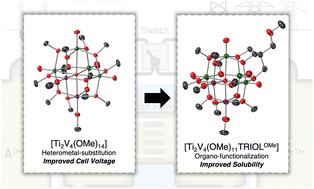Improved solubility of titanium-doped polyoxovanadate charge carriers for symmetric non-aqueous redox flow batteries†
Abstract
Non-aqueous redox flow batteries constitute a promising solution for grid-scale energy storage due to the ability to achieve larger cell voltages than can be readily accessed in water. However, their widespread application is limited by low solubility of the electroactive species in organic solvents. In this work, we demonstrate that organic functionalization of titanium-substituted polyoxovanadate-alkoxide clusters increases the solubility of these assemblies over that of their homoleptic congeners by a factor of >10 in acetonitrile. Cyclic voltammetry, chronoamperometry, and charge–discharge cycling experiments are reported, assessing the electrochemical properties of these clusters relevant to their ability to serve as multielectron charge carriers for energy storage. The kinetic implications of ligand variation are assessed, demonstrating the role of ligand structure on the diffusivity and heterogeneous rates of electron transfer in mixed-metal charge carriers. Our results offer new insights into the impact of structural modifications on the physicochemical properties of these assemblies.



 Please wait while we load your content...
Please wait while we load your content...